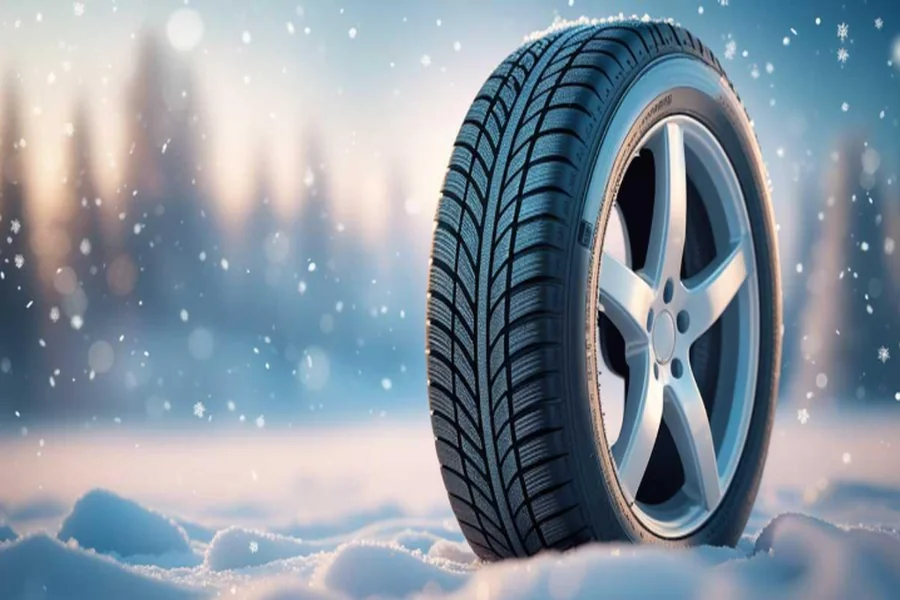When you are buying winter tires, keep your eyes glued on the peaked mountain with the snowflake symbol. Tires displaying this symbol must have certain snow traction performance requirements and have been designed to specifically perform when subjected to extreme snow environments.
Below the 7-degree Celsius mark, all-season tires and summer ones start getting hard and the tires become less tacky. The elasticity and traction of snow tires remain at much lower temperatures. Other than the winter tires, wide, high-performance tires are inappropriate on snow-covered roads.
-
Installing Your Winter Tires
In order to assist in keeping your vehicle under control and stable during icy conditions, it is recommended that you install winter tires, in sets of 4. The handling of the vehicle will be enhanced once tires of the same type, size, speed rating and load index are fitted on the 4 wheels. Mixtures of tires of various tread patterns, internal construction, and sizes should not be used because they will cause your vehicle to be less stable.
Install the best tires on the back of the car in order to maintain directional control. This implies that the tires that have the greatest tread depth should be fitted in the rear. In case your tires are regularly rotated, they are supposed to be of approximately equal tread depth.
Ensure the proper side of the vehicle has directional tires.
Tread-wear indicators of some tires can be 2mm. Tires with reduced tread near the tread-wear indicators have less traction and are not suitable for roads covered with snow or in heavy snow. Do not drive with tires with a tread depth of less than 4mm.
Insurance companies might as well offer you a discount if you have winter tires Edmonton.
-
Safe Driving in Winter
Driving during winter is not the same as driving during other seasons. The following are some suggestions that can help you drive safely.
-
Tips On Winter Driving
When you get behind the wheel, be careful and well rested and wear your seat belt.
In winter, driving may not be easy due to poor visibility and therefore one needs to be careful and attentive on the road.
Most of the holidays during winter come with parties involving the consumption of alcohol or cannabis products. When you use any of those products, you are not supposed to drive. Just drive when you are not drunk.
At times, heavy jackets and coats may be bulky and too warm in a car, particularly on a long trip. When you or one of your passengers takes off his/her jacket, keep in mind that you must always wear a seat belt. That is the law.
Snow suits and bulky winter coats might not be the best option as far as your child’s car seat is concerned. Rather, ensure that you put your child in lighter winter clothes so he/she can be belted in the car seat with a snug harness and carry an extra blanket to cover the child to stay warm.
-
Checking Tire Air Pressure
The right air pressure prolongs tread life, enhances safety and minimizes fuel usage.
Always look at the tire pressure, particularly prior to any highway driving or any long travel. When inflated correctly and in optimal condition, high-quality winter tires will ensure you have the best traction on winter roads and fuel efficiency.
A tire which is adequately inflated in a warm garage will be under-inflated when there is cold weather below zero. Tires lose pressure in cold weather, and thus checking your tires Edmonton when they are cold is your best bet. Refer to the maximum amount of pressure indicated in the owner’s manual or doorframe, but never exceed the pressure indicated on the side of the tire. You should also check your spare tire pressure.
-
Be Seen and See
Clear off all the snow you can before you begin to drive, including the tops of the hood, the roof, and the windows, and even the lights. Wipe off all the frost and mist on the windows. This can assist you in visibility on the road and prevent the snow from falling on the windshield or on other vehicles as you drive. It may even spare you a ticket, as in some provinces a fine will be levied against drivers who fail to remove all the snow from their cars.
Where driving is too risky, find a secure place to park until it is safe to drive. Pull to the side of the road as soon as it is safely possible.


